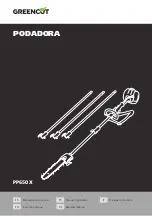
10
| English
1 609 929 K68 • 10.7.07
Assembly
Mounting/Replacing the Saw Blade
f
Before any work on the power tool itself, pull
the mains plug.
f
When mounting the saw blade, wear protec-
tive gloves.
Danger of injury when touching the
saw blade.
f
Only use saw blades that correspond with the
characteristic data given in the operating
instructions.
f
Do not under any circumstances use grinding
discs as the cutting tool.
Selecting a Saw Blade
An overview of recommended saw blades can be found
at the end of this manual.
Removal of the Saw Blade (see figure A)
For changing the cutting tool, it is best to place the
power tool on the face side of the motor housing.
•
Press the spindle lock button
5
and keep it pressed.
The spindle lock button 5 may be actuated
only when the saw spindle is at a standstill.
Otherwise, the power tool can be damaged.
•
With the Allen key
17
, unscrew the clamping bolt
18
turning in rotation direction
n
.
•
Tilt back the retracting blade guard
12
and hold
firmly.
•
Remove the clamping flange
19
and the saw blade
20
from the saw spindle
22
.
Mounting the Saw Blade (see figure A)
For changing the cutting tool, it is best to place the
power tool on the face side of the motor housing.
•
Clean the saw blade
20
and all clamping parts to be
assembled.
•
Tilt back the retracting blade guard
12
and hold
firmly.
•
Place the saw blade
20
on to the mounting flange
21
. The cutting direction of the teeth (direction or
arrow on saw blade) and the direction-of-rotation
arrow on the blade guard
1
must correspond.
•
Mount the clamping flange
19
and screw in the
clamping bolt
18
turning in rotation direction
o
.
Observe correct mounting position of mounting
flange
21
and clamping flange
19
.
•
Press the spindle lock button
5
and keep it pressed.
•
With the hex key
17
, tighten the clamping bolt
18
turning in rotation direction
o
. The tightening
torque is between 10–12 Nm, which corresponds
to hand tight plus ¼ turn.
Dust/Chip Extraction
f
Before any work on the power tool itself, pull
the mains plug.
Mounting the Extraction Adapter (see figure B)
Attach the extraction adapter
24
onto the sawdust
ejector
16
until it latches. Secure the extraction adapter
24
additionally with the screw
23
.
A vacuum hose with a diameter of 35 mm can be con-
nected to the extraction adapter
24
.
f
The extraction adapter may not be mounted
when no external dust extraction is con-
nected.
Otherwise the extraction channel can
become clogged.
f
Do not connect a dust bag to the extraction
adapter.
Otherwise the extraction system can
become clogged.
To ensure optimum extraction, the extraction adapter
24
must be cleaned regularly.
External Dust Extraction
Connect the vacuum hose
30
to a vacuum cleaner
(accessory). An overview for connecting to various vac-
uum cleaners can be found at the end of this manual.
The machine can be plugged directly into the recepta-
cle of a Bosch all-purpose vacuum cleaner with remote
starting control. The vacuum cleaner starts automati-
cally when the machine is switched on.
The vacuum cleaner must be suitable for the material
being worked.
When vacuuming dry dust that is especially detrimental
to health or carcinogenic, use a special vacuum cleaner.
Operation
Operating Modes
f
Before any work on the power tool itself, pull
the mains plug.
Adjusting the Cutting Depth (see figure C)
f
Adjust the cutting depth to the thickness of
the workpiece.
Less than a full tooth of the blade
teeth should be visible below the workpiece.
Loosen the clamping lever
25
. For a smaller cutting
depth, pull the saw away from the base plate
14
; for a
larger cutting depth, push the saw toward the base
plate
14
. Adjust the desired cutting depth at the cut-
ting-depth scale. Tighten the clamping lever
25
again.
The tightening tension of the clamping lever
25
can be
readjusted. For this, unscrew the clamping lever
25
,
and screw it back again turned offset by at least 30° in
counterclockwise direction.
OBJ_BUCH-329-003.book Page 10 Tuesday, July 10, 2007 11:37 AM











































